It’s official!
Richard E.T. White will be directing “These Streets” at ACT Theatre in 2013!
Our dream design team is taking shape!
Blog
It’s official!
Richard E.T. White will be directing “These Streets” at ACT Theatre in 2013!
Our dream design team is taking shape!
Klavihorn Countdown: ~ 2 weeks! Join us April 1 at 5pm for the world premiere of our newly restored Klavihorn at the Project Room. Members of the Fisher Ensemble (percussion master Dean Moore and the incomparable Greg Bagley) will be playing along with our guest Klavihornier for the evening, Ben Blankenship.

Come for the Klavihorn, but stay for an operatic experience: local Seattle countertenor José Luis Muñoz will be performing as part of the event as well! We’re thrilled to have him on board for this event, since he’s got an excellent voice! You may have seen him in works around town, such as the recent performance of Francesca Caccini’s La Liberazione di Ruggiero dall’Isola d’Alcina, under the direction of Stephen Stubbs at Cornish. He’s also performed with a variety of organizations, including: Washburn Symphony (Topeka), San Francisco Baroque Opera, First Congregational Church Music Series (Berkeley), Mission Cultural Center (San Francisco), Theater Artaud (San Francisco), Foro Cultural Coyoacanense Hugo Argüelles (Mexico City), the Ludinghaüsen Summer Art Festival (Germany). If you’ve never experienced the sound of a countertenor before, you should definitely come out and have a listen! He’ll be singing an aria for the Fisher Ensemble’s upcoming independent film with operatic score by Garrett Fisher entitled Magda G.
This is a free event and feel free to join us for a post-Klavihorn reception. Just like the Fisher Ensemble on Facebook as your RSVP.
There’s a ton of other great events going on as part of the Project Room’s Beginning series, so be sure to check them out as well.
Interested in the Fisher Ensemble and want to know more? Visit our website, Facebook page, or Twitter.
This is an incarnation of We Are Golden at John’s going away party at Solo Bar. He headed to San Francisco for another chapter. We will miss him dearly as we begin rehearsals on our new record.

From L to R top: Aaron Taylor, Steve Newton, John Hollis Bottom L to R: Sarah, Gretta
Sarah and Gretta (as WE ARE GOLDEN) were asked to represent the Central Heating Lab Series at ACT Theatre for the 2012 Season Preview party. They opened the show with the title song to their rock/play These Streets and then sat down for a panel discussion with Artistic Director Kurt Beattie. Their June 1st Benefit Concert for These Streets at ACT was bandied about but also much praise went out to Carlo Scandiuzzi and his commitment to making the Central Heating Lab programming at ACT abundant and well supported. Makes sense to fill that lovely building and all it’s beautiful spaces with performance in all its forms all year long!




Garrett Fisher, Ryan K. Adams, and I met yesterday with the wonderful founder of the Project Room, Jess Van Nostrand. I think it’s shaping up to be quite an event and I can’t wait to see the Klavihorn when they finally move it into this amazing space. Ben Blankenship has been helping us with the restoration and provided us with some extra materials he’s dug up about the Klavihorn – it has such an intriguing history!

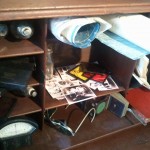
Don’t forget, you can come see the Klavihorn’s unveiling on April 1st at 5pm at The Project Room for free! We’ll be demonstrating the instrument, as well as giving you a sneak preview of some of the sounds that it will be contributing to the Fisher Ensemble’s upcoming indie film and opera production, Magda G. Another reason not to miss it: like the Fisher Ensemble on Facebook and you’ll also be invited to a reception with Garrett Fisher and core members of the Fisher Ensemble after the performance.
Interested in the Fisher Ensemble and want to know more? Visit our website, Facebook page, or Twitter.
Be sure to check out all the other events happening as part of the Beginnings series here at the Project Room.


Gretta and Sarah went to Bainbridge Island for a writing retreat to work on These Streets. Looks like a lot of fun!


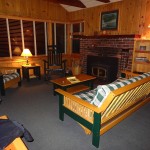

I asked a dear friend of mine, Timothy Smith-Stewart, to set a few parameters for me to work within/off… as a sort of sub-print series. Freeing it can be to have a few rules set in place. Something I have definitely done for myself the past few years working primarily with woodblocks.
And Tim’s problems? (I guess my problems now…) I didn’t know what to expect, but they are definitely set to push one into new realms through process.
And a bit about Tim: multi discipline performance sorta fellow, very social cause oriented. Great at bringing many different folks from all different backgrounds together in projects and collaborations.
PROBLEMS:
Problem 1
Problem 2
Problem 3
Problem 4
Problem 5
(THANKS TIM!) I’ll be chipping away at these the next few weeks with posts along the way- keep tuned for results.
A note from TPR Founder Jess: The idea for this exercise came to Charles after watching The Five Obstructions in TPR last fall. More about the film and its influence can be found here.
And visit Charles while he wrestles with these obstructions on Saturdays twice a month from 1-4pm. Check the calendar for specific dates!
2 Comments | Posted in: Projects | Permalink to this post
Follow-up:
charlie says:
March 10, 2012 at 9:27 pm (Edit)
And the manifesto for Problem No. 5!:
We have been up all night, my friends and I, beneath mosque lamps whose brass cupolas are bright as our souls, because like them they were illuminated by the internal glow of electric hearts. And trampling underfoot our native sloth on opulent Persian carpets, we have been discussing right up to the limits of logic and scrawling the paper with demented writing.
Our hearts were filled with an immense pride at feeling ourselves standing quite alone, like lighthouses or like the sentinels in an outpost, facing the army of enemy stars encamped in their celestial bivouacs. Alone with the engineers in the infernal stokeholes of great ships, alone with the black spirits which rage in the belly of rogue locomotives, alone with the drunkards beating their wings against the walls.
Then we were suddenly distracted by the rumbling of huge double decker trams that went leaping by, streaked with light like the villages celebrating their festivals, which the Po in flood suddenly knocks down and uproots, and, in the rapids and eddies of a deluge, drags down to the sea.
Then the silence increased. As we listened to the last faint prayer of the old canal and the crumbling of the bones of the moribund palaces with their green growth of beard, suddenly the hungry automobiles roared beneath our windows.
“Come, my friends!” I said. “Let us go! At last Mythology and the mystic cult of the ideal have been left behind. We are going to be present at the birth of the centaur and we shall soon see the first angels fly! We must break down the gates of life to test the bolts and the padlocks! Let us go! Here is they very first sunrise on earth! Nothing equals the splendor of its red sword which strikes for the first time in our millennial darkness.”
We went up to the three snorting machines to caress their breasts. I lay along mine like a corpse on its bier, but I suddenly revived again beneath the steering wheel — a guillotine knife — which threatened my stomach. A great sweep of madness brought us sharply back to ourselves and drove us through the streets, steep and deep, like dried up torrents. Here and there unhappy lamps in the windows taught us to despise our mathematical eyes. “Smell,” I exclaimed, “smell is good enough for wild beasts!”
And we hunted, like young lions, death with its black fur dappled with pale crosses, who ran before us in the vast violet sky, palpable and living.
And yet we had no ideal Mistress stretching her form up to the clouds, nor yet a cruel Queen to whom to offer our corpses twisted into the shape of Byzantine rings! No reason to die unless it is the desire to be rid of the too great weight of our courage!
We drove on, crushing beneath our burning wheels, like shirt-collars under the iron, the watch dogs on the steps of the houses.
Death, tamed, went in front of me at each corner offering me his hand nicely, and sometimes lay on the ground with a noise of creaking jaws giving me velvet glances from the bottom of puddles.
“Let us leave good sense behind like a hideous husk and let us hurl ourselves, like fruit spiced with pride, into the immense mouth and breast of the world! Let us feed the unknown, not from despair, but simply to enrich the unfathomable reservoirs of the Absurd!”
As soon as I had said these words, I turned sharply back on my tracks with the mad intoxication of puppies biting their tails, and suddenly there were two cyclists disapproving of me and tottering in front of me like two persuasive but contradictory reasons. Their stupid swaying got in my way. What a bore! Pouah! I stopped short, and in disgust hurled myself — vlan! — head over heels in a ditch.
Oh, maternal ditch, half full of muddy water! A factory gutter! I savored a mouthful of strengthening muck which recalled the black teat of my Sudanese nurse!
As I raised my body, mud-spattered and smelly, I felt the red hot poker of joy deliciously pierce my heart. A crowd of fishermen and gouty naturalists crowded terrified around this marvel. With patient and tentative care they raised high enormous grappling irons to fish up my car, like a vast shark that had run aground. It rose slowly leaving in the ditch, like scales, its heavy coachwork of good sense and its upholstery of comfort.
We thought it was dead, my good shark, but I woke it with a single caress of its powerful back, and it was revived running as fast as it could on its fins.
Then with my face covered in good factory mud, covered with metal scratches, useless sweat and celestial grime, amidst the complaint of staid fishermen and angry naturalists, we dictated our first will and testament to all the living men on earth.
March 3, 2-3:30pm: The Start-Up: Six Seattle-based makers and entrepreneurs will share their perspectives on what it takes to get something off the ground and how they made it work. Representing technology, art, food, Northwest history and other areas of expertise, these guests will discuss topics related to Beginnings, such as where new ideas come from and how they become something more. Join the conversation!
Featuring:
Sarah Bergmann – Artist & Creator of The Pollinator Pathway
Tim Detweiler – Executive Director of The Museum of Northwest Art
Susie Evans – Co-Founder of Office Nomads
Hsu-Ken Ooi – Co-Founder of Decide
Sarah Novotny - CIO at Meteor Entertainment and Co-Founder of Blue Gecko
Zephyr Paquette – Chef and Owner of Skelly and The Bean (opening soon!)
March 23 – 30: Kevin and Jennifer McCoy present Northwest Passing, an exhibition and performance featuring completely improvised tours of Northwest master works.
Northwest Passing in an exhibition that presents work from six classic Northwest Artists as a way to ask what we mean by that very phrase “Northwest Art”. The works in the exhibition, borrowed from local government, corporate and private collections, will be paired with a series of improvised stories performed by actors and other community participants who attempt to interpret the works on display.
In this project, passing has several connotations. The performers stories pass as legitimate accounts, even though they lack any foreknowledge of the work in question. As in the transgendered sense, they are passing for experts that they may not be. Passing also points to the eclipsing of this great, first generation of Northwest Artists. The exhibition asks if their artistic ideas have passed, or if they are still in play. Finally the show is about our relationship to the Northwest. I was born and raised here, went to school here. Jennifer and I were married here and lived here for a time. Do we pass as Northwest artists?
The exhibition includes works by Guy Anderson, Kenneth Callahan, Morris Graves, Helmi Juvonen, Mark Tobey, George Tsutakawa.
Improvised Tours: March 23 and 24 at 6pm
Open Hours: March 27 - 30. Extended through April 6! Tuesdays-Fridays, 10am-3pm. During open hours, the artworks are on display alongside video footage from the tours.
All events are free and open to the public; tours last one hour, so arrive at 6pm sharp!
Special thanks to Douglas and Mary-K McCoy, Perkins Coie, LLP; Woodside/Braseth Gallery; and King County Public Art Collection & 4Culture for the loan of artwork for this exhibition
About the Artists:
Jennifer and Kevin McCoy are Brooklyn-based artists who make projects about how our thoughts, experiences and memories are structured through genre and repetition. In order to focus attention on these structures, they often reexamine classic works of science fiction or television narrative, creating sculptural objects, video projections, or live events from what they find.
Their work is in the collections of the Museum of Modern Art (New York), The Metropolitan Museum (New York), MUDAM (Luxemburg), the Milwaukee Art Museum, the Nevada Museum of Art, the Speed Museum (Louisville), the Henry Art Museum (Seattle), La Maison Rouge (Paris) and the collections of many private foundations and individuals in the US and Europe. In addition to the above institutions, their work has been exhibited at P.S.1, Postmasters Gallery, The New Museum, the Ronald Feldman Gallery and the James Cohen Gallery (all in New York), The Museum of Contemporary Art (Miami), The Renaissance Society (Chicago), the Palm Beach ICA (Palm Beach, Florida). International exhibitions include “Future Cinema” at ZKM (Karlsruhe, Germany),”Animations” at Kunst Werke (Berlin), “Villette Numerique” (Paris), PKM Gallery (Beijing) and solo exhibitions at FACT (Liverpool), Sala Rekalde (Bilbao), Gallerie Guy Bartschi (Geneva) and the British Film Institute (London).
They are 2011-12 Guggenheim fellows. In 2005 they received a Rave Award and were named Artists of the Year by Wired Magazine. In 2002 they received a Creative Capital Grant for Emerging Fields and in 2001 they received an award for New Media from the Colbert Foundation. Articles about their work have appeared in Art News, Art In America, Artforum, Flash Art, Frieze, The Wire, dArt International, Spin Magazine, Feed, and The Independent, the New York Times, the Washington Post, Liberation (Paris), and el Pais (Madrid).
Their work is represented by Postmasters Gallery in New York and Gallerie Guy Bartschi in Geneva, Switzerland.
All I can say is, it takes a real Klavihorn devotee to organize all these plans & documents. Go Ben Blankenship! Ryan has been meeting with Ben and they’ve begun the daunting task of reconstructing the instrument. Hopefully in the next few days we’ll have an update from the Klavihorn front.
Check out more information about our Klavihorn project, as well as other cool projects happening concurrently.
Some sketches:




March 26, 2pm at St. James Cathedral: The Project Room hosts a conversation in the St. James Cathedral Chapel with ceramicists and collaborators Nicholas Kripal and Jeffrey Mongrain, whose site-specific work is temporarily installed as a response to the imagery and architecture of the Cathedral. Addressing the current TPR theme, Beginnings, the conversation will explore the relationship between the cathedral and contemporary art, and how these artists turn their new ideas into successful collaborations with sacred spaces. Joining the conversation is St. James Cathedral Director of Music Dr. Savage and St James Director of Liturgy Corinna Laughlin. Visitors will also hear from Seattle ceramicists Jessi Li and George Rodriguez, whose new piece “Stations of the Cross” was created for the chapel at St. James.
This program is in conjunction with The National Council on Education for the Ceramic Arts’ annual conference.
Location: 804 Ninth Avenue, Seattle. The Chapel is located adjacent to the main cathedral on the South side
About the Artists:

Nicholas Kripal is Professor of Art and Chair of the Crafts Department, Tyler School of Art, of Temple University. He received his M.F.A. degree from Southern Illinois University, Edwardsville, and his B.F.A. degree from the University of Nebraska, Kearney. His awards and grants include a Pew Fellowship in the Arts, 1999, Pennsylvania Council for the Arts Fellowships 1987,1992,1997
Jeffrey Mongrain grew up in the small northern Minnesota town of International Falls, traditionally the coldest place in the continental United States. As a ceramic artist he circumvents the traditional use of clay in his work by using the medium to explore content. Many of his objects have a relationship with the Victorian buildings of Glasgow, Scotland where Jeffrey lived and taught for seven years. Jeffrey Mongrain holds an MFA in ceramics from Southern Illinois University and has had solo exhibitions in Europe and the U.S. He is currently the head of the ceramics department at Hunter College, CUNY.


Exciting news ladies and gents!
Sarah and Gretta entered Dubtrain Recording Studio in West Seattle to record their new song “These Streets” with engineer Pete Remine.
“These Streets” is appearing in their upcoming fundraising video.
Can’t wait to see the video!
March 22, 6pm: Spilled Milk: A conversation with food writers and podcasters Matthew Amster-Burton and Molly Wizenberg, moderated by Langdon Cook.

Listen to this event!
As part of Beginnings, Matthew Amster-Burton and Molly Wizenberg share how the Spilled Milkpodcast program began, what role humor plays in their ideas, and what to make of the current popularity of food writing. Langdon Cook guides the conversation about this and other interpretations of the theme “beginnings.” As always, The Project Room audience is encouraged to join in the discussion!
About the Participants:
Molly Wizenberg is a writer and photographer. She is the voice behind Orangette, named the best food blog in the world by the London Times, and her first book, A Homemade Life: Stories and Recipes from My Kitchen Table, was a New York Times bestseller. Her work has been published in the Best Food Writing series,The Washington Post, The Art of Eating, and Creative Nonfiction, and she wrote a monthly column in Bon Appetit from 2008 to 2011. With her husband Brandon Pettit, she owns the restaurant Delancey, in Seattle. She is currently working on her second book.
Matthew Amster-Burton is the author of Hungry Monkey: A Food-Loving Father’s Quest to Raise an Adventurous Eater. He has written for Gourmet, the Wall Street Journal, and the Seattle Times, and has been featured in the Best Food Writing anthology repeatedly.
Author of Fat of the Land: Adventures of a 21st Century Forager, Langdon Cook is a writer, instructor, and lecturer on wild foods and the outdoors. Cook has been profiled in Bon Appetit, WSJ magazine, Martha Stewart’s Whole Living, and Salon.com, and his writing has appeared in numerous magazines and newspapers, including Sunset, Gray’s Sporting Journal, and Seattle Magazine. His on-screen credits include webisodes of The Perennial Plate and a forthcoming Food Network episode. Langdon’s next book is titled The Mushroom Hunters (Ballantine 2013).
One of the more amazing items in the Klavihorn stash is a journal that includes some notes about the instrument’s construction.
Open it up,
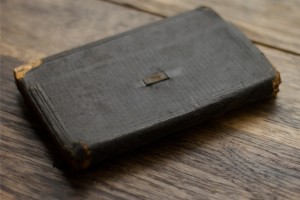
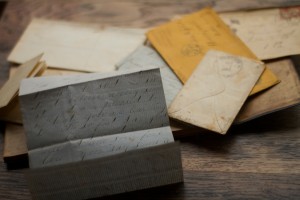
And you will find some letters.
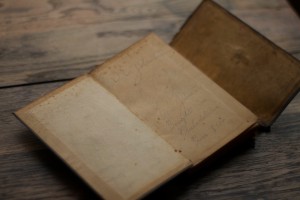
In researching the history of the Klavihorn, we came across a couple other, similar instruments:
The Telharmonium was developed by Thaddeus Cahill in 1897.

The Telharmonium with palm fronds as accompaniment
The electrical signal from the Telharmonium was transmitted over wires; it was heard on the receiving end by means of “horn” speakers. The Telharmonium used “tone wheels” to generate musical sounds as electrical signals by additive synthesis. Cahill built three versions: The Mark I version weighed 7 tons. The Mark II version weighed almost 200 tons! (In other words, it wasn’t exactly an instrument suited for marching band.) Some of the first performances were heard at “Telharmonic Hall” at 39th and Broadway in New York. Here is an original Telharmonium blueprint:
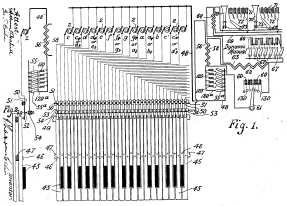
No recordings exist of the Telharmonium, and because of its immense weight, size and power consumption, it fell into obscurity. Another interesting tidbit:
“problems began to arise when telephone broadcasts of the Telharmonium were subject to ‘crosstalk’ and unsuspecting telephone users would be interrupted by strange electronic music.” (Wikipedia)
Sounds like John Cage to me.
Another early electronic instrument was the Clavilux, built by Thomas Wilfred in 1919. The Clavilux was a device used to perform “Lumia,” which was Wildred’s term for “Light Art.”
“Lumia as conceived, was a self contained and silent art, not to be combined with music or dance. Wilfred, being a pragmatist, would occasionally experiment or collaborate with other artists and disciplines (most notably for a performance with Maestro Leopold Stokowski and the Philadelphia Symphony at Carnegie Hall) (Wikipedia).
You can buy “5 Thomas Wilfred Lumia Compositions” as well as view visual samples here…
Seattle’s AJ Epstein is currently in the process of restoring a Clavilux, and I’m hoping to create an interdisciplinary duet for the ‘lux and the ‘horn (as I, too, am a pragmatist).
Check out more information about our Klavihorn project, as well as other cool projects happening concurrently.
Just looking at the ripped posters of the era you can tell Seattle was on the cusp of something. Bold designs and haphazard band names that sound like crossword puzzle clues strewn across neon yellow paper. It was a time of making art simply for art’s sake. There were no alterior motives.
I felt drawn to These Streets because of my past. I can identify with those posters. The venues I see in videos remind me of the bars in my hometown the patched cables and indistinct vocals bring the nostalgia rushing through my head so fast I can smell the cigarettes, the floor is sticky from 100 beer spills and so much dancing! I’m sixteen and as I ease my 1978 Thunderbird into the parking lot of the F.O.E. I can already hear drums pounding through the walls of the ramshackle building. The crowd is a mix bag. There are kids my age, 20 somethings and dirty old men that will buy you Jack and Cokes if you nod your head while they tell you their stories of ungrateful wives and forced retirement.
I remember one band, The Front, while all the other bands were full of rowdy drunk boys, this band was a girl band. And man I thought they were so cool. While most of the bands toward the end of the night were too drunk to play, this band was on top of it. They never missed a beat. It felt like they were on a mission like they needed to prove something. And although I don’t frequent the F.OE., or anything of the like, anymore. That band sticks out to me. They knew what they wanted in that moment. It meant a lot to a sixteen year old girl who had no thoughts to the idea of desires past finding someone to buy me beer after the show. The memory of those girls playing stands clear in my mind while the rest of my bar show experiences are a bit foggy.
Last night we set up a lovely dinner at the Project Room with some of the women that were part of the music movement in Seattle during the late 80s early 90s. It was great hearing their stories and beginning to understand the world they lived in and even drawing connections into my own world. They really aren’t that different after all.
Gretta brought some of her old band t shirts. Some of them she had made herself. I also have band t-shirts sitting in the back of my closet in Billings. They have been spray painted with care in the alley behind my house (my dad didn’t want me to get paint on the grass in the backyard). We all have stories of our favorite bands that no one else has heard of and in that moment when you talk to someone that was there, that remembers that obscure band name, you can relate to that person on a whole new level. You may disagree about one hundred other things in life but the fact remains that you were there together and no one else can understand exactly what it was like. It’s empowering to have a group behind you, dancing in the middle of the room like you never left the backstage where you weren’t necessarily supposed to be in the first place, remembering (barely) the words to that one great song.

That is why this project is important to me. It’s a look into the past, a glance at the things that have shaped us. It is important to know your history, so we can see exactly what we have become and to understand that all of that still can change. We have a lot of life to live.

"Introduction" 9"x13" woodblock 2011
This first print came to me directly, which the majority of my work does not. It clearly says “hello!”, here I am, and it becomes the simple task of laying it out visually, drawing in the details, choosing layers, carving and printing the block.
This first print is titled “introduction”. Loosely based off the Project Room and it’s origin, the image resembles a maze of temporary gallery walls, one having fallen over exposing the wooden framework it is made of.
I agreed to pursue The Project Room Print Series, a collection based off questions arisen at the Project Room as well as reacting to the other pieces present there, for a multitude of reasons. I am excited to challenge myself and question why I create, and ask why I have made the choices I have made, and look deeper into my personal motivations. Along with questioning my own endeavors, I am also excited to work responding to others process and thought, important in expanding to greater understandings and uncharted territory. I am also excited to explore why we as a whole create and have done so throughout history, and dive into a realm of unknown.
For those reasons and others that will come, I am eager accept this challenge. I see it as a challenge as it forces myself to question and critically explore concepts I have readily avoided (more on that to come). And in following with my philosophy- I deeply believe in breaking down preconceptions and opening ones self up to new possibilities in reach for a greater perspective.
Charles will be working in The Project Room every other Saturday starting February 11, from 1-4pm. Read more about his project.
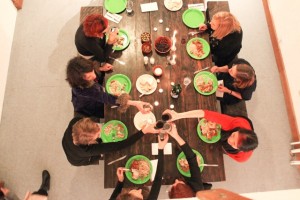
Image: Sarah Rudinoff, Fiia McGann, Barbara Dollarhide Pritchard, Rhonda Pelikan, Laura Weller Vanderpoole, Kim Virant Sheryl Wiser, Molly Lannon Kenny, Gretta Harley Jess Van Nostrand in discussion at The Project Room as part of These Streets. Photograph by Sarah Jenks.
The recession of 1971 that brought the Boeing Bust was humorously commented on with a famous billboard posted at S 167th Street and Pacific Highway S near Sea-Tac International Airport that read “Will the last person leaving SEATTLE — Turn out the lights.” That self-deprecating humor still prevailed in 1989 when the young musicians who grew up 1970s Seattle now played with and to each other in small clubs. Young musicians from other parts of the country started moving to Seattle in the late 80s and early 90s adding their energy to Seattle music scene. As the band numbers grew, more clubs opened, indie record labels started. The post punk DIY ethics propelled musicians on regional tours. Musicians glue pasted hand made posters to telephone polls to advertise their shows. Local artists silkscreened T-Shirts. Small indie zines reviewed records and interviewed bands. A small living was eeked out by some, and others subsidized their passion with music through odd jobs. There was a scene here. A quiet, supportive, DIY scene.
In 1989 Seattle was largely thought of a sleepy, blue collar town. Microsoft hadn’t reached a billion dollar corporation yet, Amazon wasn’t an entity and Starbucks had not launched nationally. There was no internet. There were no cell phones. Seattle was an affordable place to live, and young people could share a rented house- paying minimal rent- with a basement to practice music in.
In 1991 the lights of the world were turned up in Seattle with the popularization of “grunge” music. The lives of the young people who were part of a small, supportive music community were forever changed. Many stories have been told, books written, films made, retrospectives celebrated, but mostly absent are the abundant women that owned labels, booking agencies, management companies and of course, led rock bands. Women toured, recorded, played live, and rocked.
Rudinoff and Harley have been interviewing musicians and gathering stories since mid 2011. They are using these real-life stories as the foundation of the play that tells of five musicians who share a house from 1989-1994. The characters are amalgams, but what is real are the stories, the flavor and the music.
The aspects to THESE STREETS are:
• a theatrical /rock music show that will premier at ACT’s historic Allen Theatre in February/March 2013
• a historical archiving of women in the Seattle rock scene- in the late 80s/early 90s- who led bands, toured, recorded, started record labels…rocked, thus adding women to the historic legacy
• a retrospective visual art show of women musicians in the late 80s/early 90s in Seattle
• an educational project aimed at adding music written by women to the standard rock repertoire taught to kids
Friday February 3, 7pm
These Streets: Musicians Gretta Harley and Sarah Rudinoff (We Are Golden) share their experiences behind their rock musical-in-progress; and offer their perspectives on cultivating a new idea, while living in Negative Capability(*).
Welcome to the women behind the Seattle rock community from those infamous years 1989-1994, as We Are Golden (Sarah Rudinoff and Gretta Harley) share music, stories and images while taking you into their process of creating the original rock play/musical, These Streets. They will also discuss making music now, youthful passions, unintended consequences, and what happens when a bright light shines on a dark city.

The late poet John Keats coined the phrase “Negative Capability” as the ability to be “in uncertainties, mysteries, doubts, without any irritable reaching after fact and reason.

As part of the Failure series, TPR is following the work of Paris-based visual artist Veit Stratmann. Stratmann, whose work often results in proposals that purposefully cannot be realized, is studying the Italian city of L’Aquila after it was evacuated during an earthquake and never repopulated. As Veit writes in his introductory essay on the subject, L’Aquila is in a middle state, neither a ghost town nor a functioning city.
Read an introductory essay about L’Aquila on Off Paper here:
And read a follow-up essay here:
Wednesday, February 6 @ 6pm: Join us for a conversation with Veit as he shares his responses to L’Aquila and other projects in a presentation titled “Impossible Tasks.” And follow the development of Veit’s ideas through this website as the project continues.
About the Artist:
Born in Bochum (Germany), Veit Stratmann lives in Paris. Stratmann’s work essentially rests upon questioning: can an artistic gesture be based on the notions of choice, of decision-making, of the posture of those who encounter the artwork? Can this decision-making become constructive material? If political action originates in the act of making a choice, can an encounter with art generate a permanent oscillation between a political and an artistic gesture? Can an artistic gesture undo the coherence of a space without affecting its physical integrity, create a “parenthesis” or construct a loophole in its meaning in order to generate a statutory blurring? Can this statutory blur become creative matter?
The artist’s works are often site specific although he has also shown extensively in gallery and museum contexts. Drawing and writing are also ongoing areas of engagement for Stratmann as tools of projection, control and distancing. In 2004, a residency at the Atelier Calder (Saché, France) was the occasion for the artist to create a new series of objects and to integrate them with images realized in 3D. And in 2009, he realized a photographic series of ex-votos in gardens that was published as an artist book, Shrines by Les Presses du Réel.
VS has exhibited widely and internationally. At the Museum Folkwang in Essen, Fondation Serralves in Porto, Musée d’Art Contemporain du Val de Marne MAC/VAL, Vitry sur Seine (France) , Sox in Berlin, Le Centre d’Art et de Diffusion Clark in Montréal, CAPC-Musée à Bordeaux, The Project Art Centre in Dublin, The Taedok Science Town in Taejon (South Korea), LiveInYourHead-Institut Curatorial de la Haute Ecole d’Art et de Design, Geneve, L’Institut d’Art Comtemprain in Villeurbanne, The Anderson Gallery at the Virginia Commenwealth University in Richmond, Virginia, The Nevada State Museum of Art, Reno, Nevada, La Fondation Miro in Barcelone, Le Musée d’Art Moderne de la Ville de Paris, le Saarlandmuseum à Saarbrücken and Galerie Chez Valentin in Paris.